
The TechFest experience comes to Northwest Arkansas on July 8th, 2010. This will be the first Northwest Arkansas TechFest organized by David Walker
What is the Northwest Arkansas TechFest?
The Northwest Arkansas TechFest is a technical conference primarily focused on providing training/teaching sessions that are immediately beneficial to the broadest range of IT Professionals. The event is also organized in such a way that you can learn and give back to the community. This non-profit event is organized by local volunteers and even though this is a free event you are encouraged to bring two cans of food or two bucks. All canned food will be donated to the Northwest Arkansas Food Bank and all proceeds will be donated to The Jones Center
Speakers
Myself and several other local speakers will be presenting at this event, as well as, several well known speakers from around the country.
Here is information about the sessions I will be presenting.
Visual Studio 2010: Config file transformations
In any development environment we have to code local, publish to test, and then have the tested code published to the production environment. The process has built in gates to ensure that bad code doesn’t make it into production, but it causes a huge issue with keeping up with service and database connections in your configuration files. Visual Studio 2010 introduces Web.config transformations as a way to solve this problem. In this session we will look at the age old problems, discuss some solutions in use today and take a look at how Visual Studio 2010 has solved this problem for us today.
Estimate Your Requirements With Planning Poker
Planning Poker is a consensus-based estimation technique for estimating, mostly used to estimate effort or relative size of tasks in software development . It is a variation of the Wideband Delphi method. In this session you will learn not only what planning poker is but how to facilitate it with your team. Using Planning Poker to estimate task on your project is not only accurate its fun.
When:
Thursday, July 8th, 2010
Where:
Center for Nonprofirts @ St. Mary’s
1200 West Walnut Street
Rogers, AR 72756 [MAP]
Registration:
You can pre-register or register the day of the event. Pre-registering will save you a lot of time. This is a free event, however you are encouraged to bring TWO CANS or TWO BUCKS. All canned food will be donated to the NWA Food Bank and all proceeds will be donated to The Jones Center.
On a recent project we used custom Visual Studio build files to build and deploy the code to different environments, i.e. Test and Production. We created command files to pass the correct arguments to the build so it would be easier to run. We never liked the fact that we need to open a command window and navigate to our solution folder to run the builds. We thought, “There has got to be a way to do that from with in visual studio”, and we were right. Devlin Liles details the steps we used to set that up in Visual Studio 2008 in his blog post titled Batch File and Command File running In Visual Studio.
I wanted to set that up in Visual Studio 2010 today and found the steps a little different so wanted to share how to set it up in Visual Studio 2010.
To realize the ability to execute command or batch files from within Visual Studio 2010 we need to perform the following steps:
- Create the External Command
- Adding the Command to the Context Menu
Setting up the External Command
- Open the External Tools dialog by opening the Tools->External Tools menu.
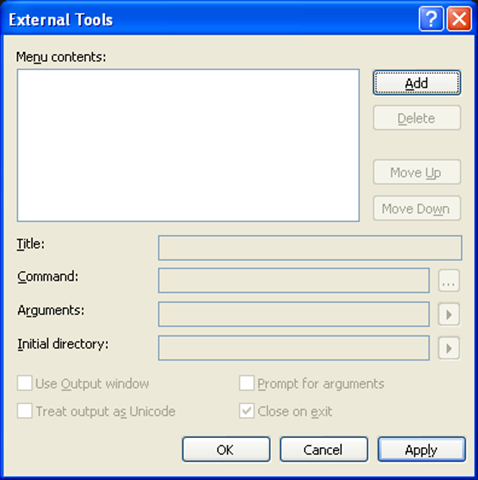
- Click the add [Add] button to create a new External Tool and enter the following information:
| Title | E&excute Command… |
| Command | C:\WINDOWS\System32\cmd.exe |
| Arguments | /K $(ItemPath) |
| Initial directory | $(ItemDir) |
| Use Output Window | Checked |
| Prompt for arguments | Not Checked |
| Treat output as Unicode | Not Checked |
- Click the [Apply] button to save these changes, but before you click [OK] take now of a how many External Tools are listed here. In my case it was the only external tool that had been defined so it will be assigned to External Tool 1.
- You can click [OK] now to close the External Tools dialog.
Adding the Command to the Context Menu
Now that we have our external command created we need to add it to the context menu for Solution Explorer items.
- Open the Customize dialog by right clicking somewhere in the toolbar area to bring up the context menu and selecting Customize from the bottom of the menu.
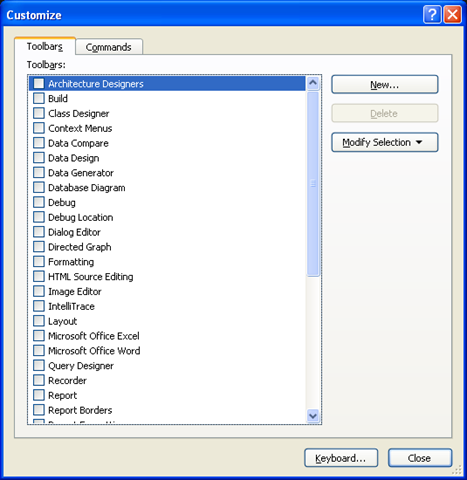
This is where the steps for Visual Studio 2010 are different than Visual Studio 2010. If you are using Visual Studio 2008 follow the instructions on Devlin Liles blog.
- Select the [Commands] tab

- Under Choose a menu or toolbar to rearrange: select Context menu: and in the drop down select Project and Solution Context Menus | Item.
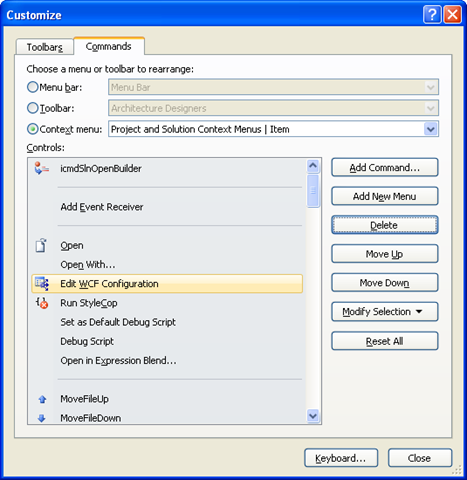
I want my “Execute CMD…” command to be positioned above the “Edit WCF Configuration” items, so select “Edit WCF Configuration” and click the [Add Command…] button.
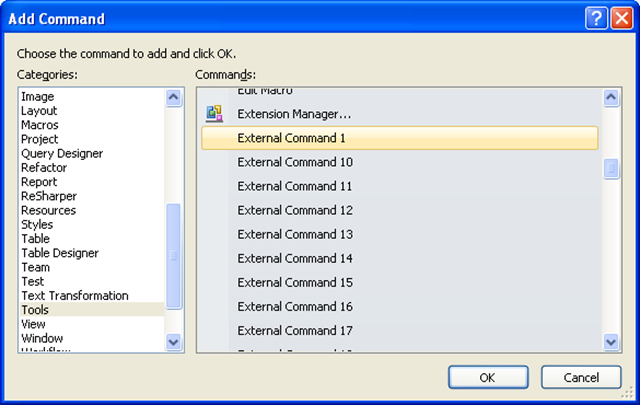
- On the Add Command dialog in the Categories list select Tools. Know in the Commands list scroll down until you see the External Command you are looking for. Remember ours was External Command 1. Once you find it select it and click [OK].
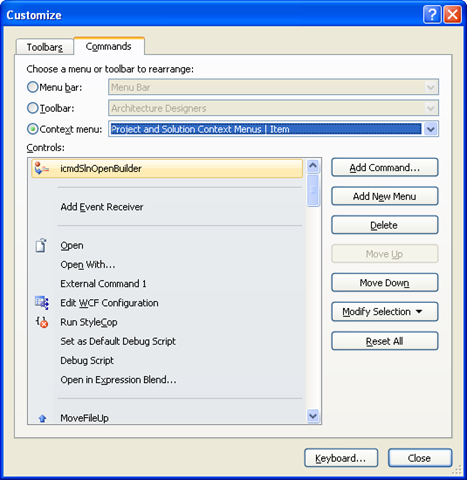
Now we see that External Command 1 is shown above the “Edit WCF Configuration” command, right were I wanted it.
- Now you can click [Close] button, open a solution and when you open the context menu in Solution Explorer you see the following:
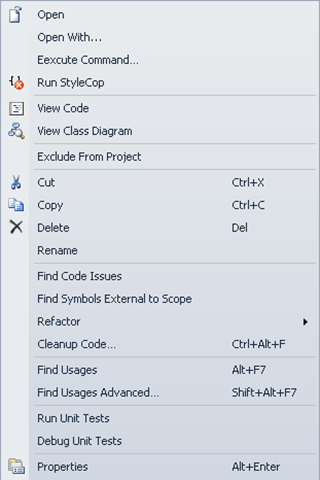
Summary
This addition to Visual Studio has come in really handy for running common commands or batch files you might need to automate more mundane task.
Introduction
This is part two in a multipart series discussion Open Space Technology. Last time we looked at the 4 Principles and the 1 Law that many attribute to the success of Open Space Technology. Today we are going to look at the Opening Circle and the Market Place.
Other Post in this series:
- Open Space Technology: Introduction
- Open Space Technology: Opening Circle
- Open Space Technology: Sessions, where the sharing happens

The Opening Circle
At the beginning of an Open Space the participants sit in a circle. A facilitator is responsible for greeting all of the participants and reminding everyone of the purpose, principles and the one law. Participants are then invited to identify any issues or topics they feel should be discussed. This process doesn’t take long and it is amazing to see how a group can come to order so quickly in this format. While attending devLink 2009 and eagerly awaited Alan Stevens to kick off the opening circle I noticed that everyone was talking have have a great time. Alan walks into the circle, doesn’t say a word, just starts pacing in a circle. Amazing, within a few short minutes everyone stopped talking and started focusing on Alan. Once the room was quiet Alan kicked it off. It was amazing to experience, if ever get a chance to go to an open space facilitated by Alan Stevens go, he is excellent.
As I stated earlier, the opening circle is where everything is explained the 4 principles and the 1 law and generally sets the tone for how the rest of the open space is going to flow, communicating schedules, needed resources, closing circle, etc.

The Market Place
Once the general flow is communicated it comes down to setting the schedule, I mean we all want to know what we are going to talk about right? ;-). That is where the Market Place comes into play. The Market Place is a blank schedule showing times and rooms but no topics. The facilitator encourages the participants willing to raise a topic to come to the center of the circle, write it on a sheet of paper and announce it to the group before choosing a time and a place for the discussion and posting it on a wall. That wall becomes the agenda for the meeting.
No participant is forced to suggest issues/topics, but anyone may do so. The person who posted the topic is responsible for being at the session at the chosen time and place, start the discussion, have someone take notes and post them on the wall when the session is over. It is important to note that this is not a speaker lead session; it is a discussion had by everyone that shows up to talk about the given topic.
When all time slots have been filled, participants sign up to attend sessions. Wow, that is a full day of topics organized in about 30 minutes; this is the definition of self organizing. Once the schedule is finished the Open Circle is done and participants start breaking up to begin the first sessions.
Summary
The Opening Circle and the Market Place is where the Open Space Technology really shines. This is where the attendees create the list of topics THEY want to talk about and decide WHEN they want to talk about them. I one or two day conference can be organized in about an hour with very little input from the facilitator.
When I describe this to some they say, “But you will only get the passionate people to come and suggest things”, to which I reply, EXACTLY. That is the point, you want the passionate people to be there, you want them to bring up topics they are passionate about, and you want others that are passionate about it to get together and discuss it. If you are not passionate about it and aren’t getting anything out of it or contributing anything, why are you there?
The opening circle is where the attendees take control of the conference by suggesting topics that they want to talk about that they feel they will get the most value out of. It is an awesome, organic feeling to know that, YOU, has an attendee have that much control over something you want to attend.

I was recently contacted by Michael Akerman (mike@cavern.uark.edu), one of the leaders of the Northwest Arkansas Java User Group, he is looking to grow the membership of the group and start to hold monthly meetings. Their current membership, according to the website, is about 25 and they primarily communicate via two listservs, which are listed on their website.
If you are working in Java this is a great opportunity to help build and sharp the Java Community in Northwest Arkansas. If you are interested please contact Michael Akerman at mike@cavern.uark.edu and he can get you added to the list.